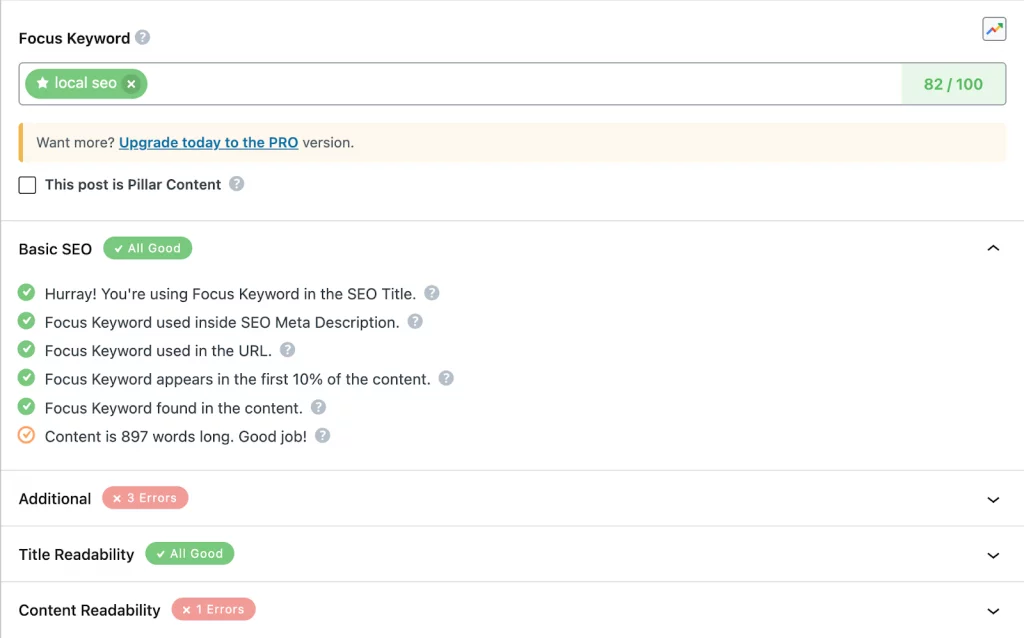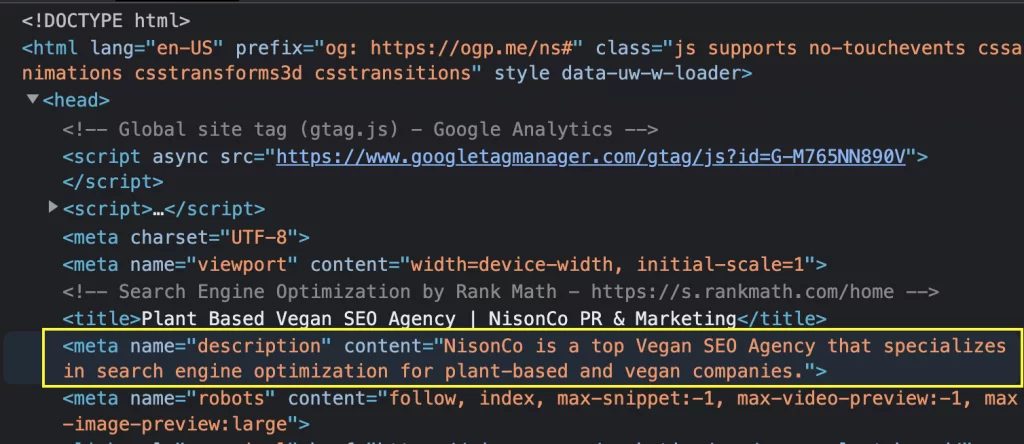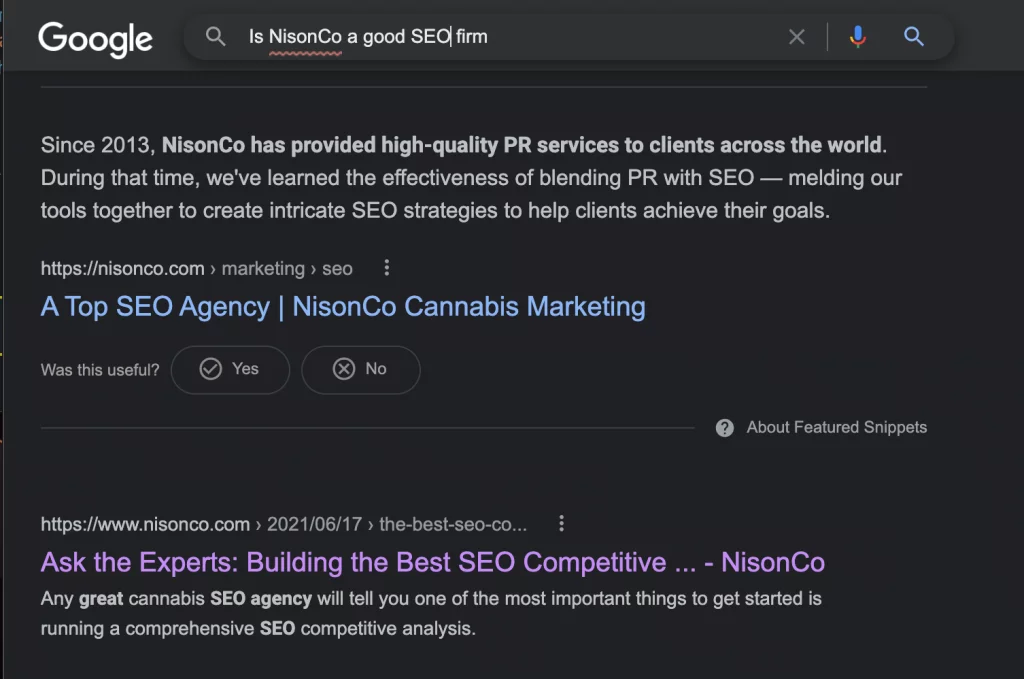Meta tags play an essential role in search engine optimization (SEO) for your business’ website, whether you’re vying to appear on the first page of results on Google, Bing or other search engine results pages (SERPs). This article will give you an essential understanding of meta titles and meta descriptions, how they’re generated, and how they ultimately play into the snippet displayed on a SERP.
What is a Meta Tag?
Meta tags appear in HTML under the <head> section and summarize the content on your web page for SERPs. You can also input your meta tags using SEO tools like the Yoast SEO or Rank Math SEO plugins for WordPress.

You can input your meta tags using SEO tools like the Yoast SEO or Rank Math SEO plugins for WordPress.
If done well, certain meta tags can aid in search engine optimization by suggesting to SERPs the keywords your page should rank for and therefore obtain higher domain authority than your competitors in the long run. Meta tags also significantly improve the accessibility for individuals who access the internet through screen readers. There are various meta tags, such as meta titles, meta descriptions, and other types we won’t touch on in this piece — nofollow and dofollow tags, canonical links, OG meta tags, the now-obsolete keyword meta tag, and many more.
How and Why to Write a Meta Title
Meta titles, also known as title tags, are written in the format <title>Insert title</title>.

Meta titles, also known as title tags, are written in the format.
These title tags display as the title of your webpage on SERPs, appear as the title on the tab in your browser, and show up as the title when cross-posted on social media (provided you haven’t also set up OG meta tags).
As of 2021, Google stated they display the coded meta tags more than 80% of the time, which means that about 20% of the time, they choose to display a meta title seen as more accurate and descriptive to the content of the webpage. However, you can use specific techniques to encourage Googlebot to show the title you’ve spent valuable time composing.
The Dos of Writing Meta Titles
- Keep it to 50-60 characters
- Give each page a unique meta title
- Use keywords mindfully
- Use keywords naturally toward the beginning of the statement
The Do-Nots of Writing Meta Titles
- Avoid making your title too long
- Resist spamming it with keywords
- Do not repeat titles with boilerplate language
How and Why to Write a Meta Description
Meta descriptions are also displayed in the <head> portion of an HTML document, and the syntax for them, if hardcoding your website, is <meta name=”description” content=”Your description goes here.”/> These meta descriptions can be used to generate snippets, which are the short blurbs about your web page that appear under the title on a SERP.

Meta descriptions can be used to generate snippets, which are the short blurbs about your web page that appear under the title on a SERP.
While Google has stated that meta descriptions do not contribute as a ranking factor, it is still a good idea to include thoughtful keywords and descriptions. Meta descriptions help users determine if your content meets their needs and is trustworthy. In turn, this encourages people to click on your webpage. Ultimately, more visitors to your website means Google is more likely to increase your ranking authority.
A study of 192,656 top-ranking web pages shows that Google rewrites meta descriptions 62.78% of the time. Yet, there are still ways you can encourage Googlebot to indicate your preferred meta description and snippet.
The Dos of Writing Meta Descriptions
- Keep it to 155 characters or less
- Use keywords toward the beginning
- Keep it relevant to that specific webpage
- Vary your longtail keywords
The Do-Nots of Writing Meta Descriptions
- Avoid spamming the description with keywords
- Do not write for robots and algorithms; write for human users
- Resist overusing irrelevant emojis
Creating Snippets through Rich Results
Another way to encourage Google Search to display your webpage and snippets in your preferred manner is by utilizing structured data to create rich results. Structured data gives more explicit indicators of the type of content on your webpage and how it should be displayed. Some examples are Events, How-tos, Local Businesses, and Review Snippets.

Using structured data could promote your webpage to be highlighted as a search result feature, such as a Featured Snippet or Knowledge Panel Entry.
Using structured data could also promote your webpage to be highlighted as a search result feature, such as a Featured Snippet or Knowledge Panel Entry. However, it is not guaranteed, and Google considers many factors for these features.

Proper rich results can result in featured snippets.
One way to implement rich results is through JSON-LD, or JSON for Linking Data, a specific type of structured data format. Structured data gives a “type” to each webpage and can attribute the scope of the webpage, as well as various properties and embedded items.

One way to implement rich results is through JSON-LD, or JSON for Linking Data, a specific type of structured data format.
For more information on structured data, visit schema.org.
Obtaining domain authority can take time and is based on thousands of criteria. Still, it’s one of the ways our SEO professionals and others agree is worth paying attention to while trying to drive traffic to your website.
Are you seeking help from our experienced psychedelics, cannabis, CBD and crypto/blockchain PR, SEO and marketing team? Let us know if you need help researching trends and topics, crafting communications, or securing news spots by contacting NisonCo here.



